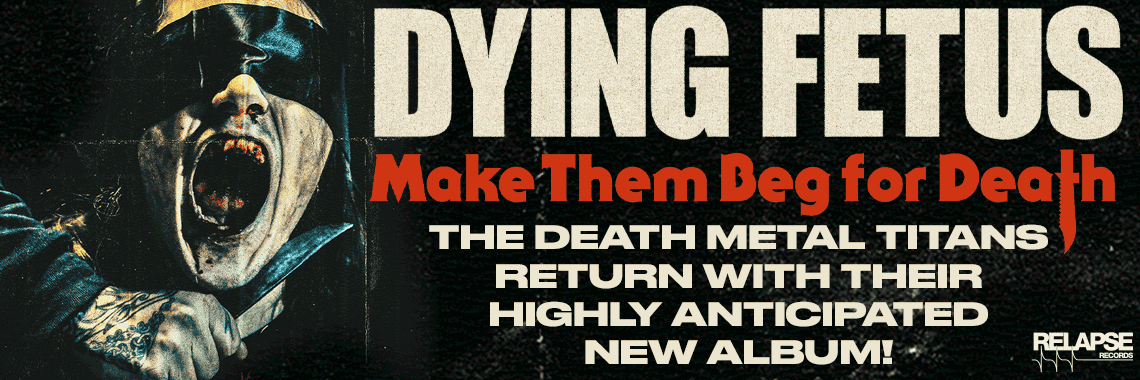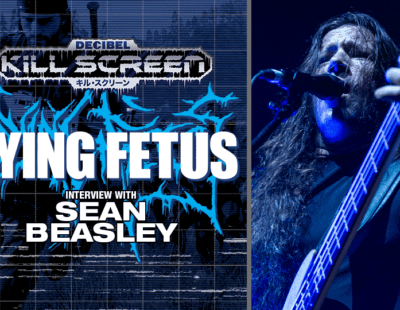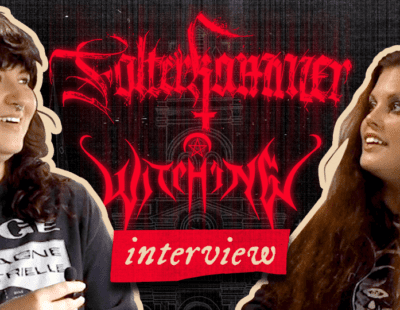
Halloween is only two days away, which means everyone from your T. Swift-listening cousin Kelsey to your D. Trump-supporting Grandma Rose will spend 24 hours reveling in all things wicked and macabre. Alas, for us metal fans, it won’t be much of a change of pace. Whether it’s Armored Saint ripping it up in Hellraiser III: Hell on Earth or the gore-soaked lyrics of Cannibal Corpse, Autopsy and seven billion other death/black/grind/etc. bands, we’re used to metal and horror co-exisiting in one convenient package. Two sides of the same coin, born to pat each other on the rotting back.
The same is true for many of our allies in cultural academia, including Toronto-based sociologist, writer and podcaster Andrea Subissati. For Andrea, horror isn’t something that’s celebrated once a year with pumpkins and costumes—it’s part of her everyday life. In addition to working for Canadian horror magazine Rue Morgue, she’s a published scholar of zombie cinema and the co-host of a monthly podcast called The Faculty of Horror, which analyzes the social impact of genre classics like The Texas Chainsaw Massacre, Rosemary’s Baby and The Exorcist. We talked to Andrea ahead of All Hallows’ Eve to get her take on horror, metal and why the two are eternally intertwined.
What’s your history with heavy metal? Do you remember the first time it “clicked” for you?
Growing up in the MTV age, my first exposure to metal was through music videos. It was the aesthetics in metal videos that drew me in, which makes sense for a horror fan. I loved Alice Cooper’s wardrobe and sets and the surreal imagery in Tool and Rammstein videos. The great music that accompanied them was like a bonus!
What’s your history with the horror genre? Do you remember the first horror movie you watched?
It’s not a proper horror movie per se, but the first scary, R-rated movie I saw was Terminator 2: Judgment Day on VHS. I’m the youngest of three siblings, so of course, everyone was worried I’d get scared and have nightmares about robot skeletons, but I didn’t…I was fascinated with the imagery and inspired by the ideas. To this day, that’s why I’m a horror fan—horror ignites my imagination and challenges my mind rather than talking down to me or trying to sell me on conservative ideals.
Metal and horror occupy the same general space in the entertainment industry—they’re both sort of marginalized yet have incredibly loyal fan bases that make them viable. How do you see the relationship between metal and horror? Do you think they come from the same place of artistic expression?
Popular culture is essentially engineered to be palatable; to go down easy and appeal to the widest possible audience: humanity’s lowest common denominator. Horror and metal both evoke strong, aggressive feelings and counter-cultural attitudes. I think that’s what they have in common, and the loyal following is necessary to keep stuff like that alive. Horror filmmakers and (most) metal musicians aren’t in it to get rich or see themselves on the cover of People magazine. They’re passion projects that stem from a subculture, which is why they’ve remained so authentic (in spite of the mainstream occasionally taking an interest in them).
Why do you think people are drawn to horror and metal in general? What is it about the human condition that makes us want to explore disturbing, terrifying situations in our art?
In reality, we’re surrounded by terrifying and disturbing imagery every day. Racism, homophobia, sexism and fear are so deeply ingrained in Western culture that you see it everywhere, particularly in advertising. For me, it’s something of a relief to see zombies devour a high school full of kids rather than hear [a news story] about a kid bringing a gun to school and shooting up his classmates for no reason. War in Iraq? I’d rather watch a war against vampires. Horror movies reify my faith in humanity, whereas the horrors of everyday life tend to bum me out. I think it’s the same with metal—stop singing me lullabies, I wanna hear something raw!
A lot of metal bands use the horror genre as inspiration for their aesthetic presentation, like Ghost with their Satanic Pope frontman and Gwar with their monster costumes. What is it about the horror aesthetic that fits so well with extreme music?
Again, I think both metal and horror fans are fed up with being lied to and spoon-fed fairy tales about the American Dream. Metal seems to follow similar trends to horror. Today’s horror filmmakers are standing on the shoulders of the ’80s slasher films that inspired them as kids, and many of the metal bands we interview in Rue Morgue lately cite Goblin and Ozzy as their influences. Ghost and Gwar are great examples of the post-Internet era of metal, where music is readily available online so bands build their notoriety and fan base through touring and putting on amazing, theatrical shows. Fans expect more from concerts now, and metal has really risen to the occasion.
Your podcast, The Faculty of Horror, is excellent. The way you and [co-host] Alexandra West deconstruct horror films from both an artistic and social standpoint is very effective. What’s the history of the show?
Thanks for the compliment! The Faculty of Horror was largely Alex’s brainchild; we had both been guests on the Rue Morgue podcast and we enjoyed it so much that Alex pitched the idea of starting our own. We didn’t set out with a specific agenda, other than the fact that we knew we’d be taking an academic approach to horror, so that’s how we landed on the name. I knew nothing about audio recording or editing, so I grabbed a USB Rock Band mic and downloaded some free audio editing software and learned as I went along! The response has been terrific from the beginning, and we’re so fortunate that our audience is passionate and eager to interact with us; it makes the show a very rewarding experience. It’s a lot of work, but I feel like it really matters, which is what keeps us going!

You’re a published expert on the zombie genre. If you could hire a metal band to score a zombie movie, who would you choose?
It would have to be something doomy, cold and industrial. I’d see if Killing Joke would be interested in collaborating with Rammstein on something.
What’s your favorite horror movie of all time?
Night of the Living Dead. It’s just so bleak. You put that movie on and it’s like, OK, playtime is over. You’re driving through an idyllic American countryside and then BOOM…everything is fucked and will never go back to the way it was. The scariest part of that film is how people can’t seem to shake their old sexist and racist hang-ups to just cooperate and survive the onslaught. I don’t worry about a zombie invasion, but if something similar happened (like a nuclear holocaust or some Mad Max situation), things would look like Night of the Living Dead pretty quick.
What’s your favorite metal album of all time?
Full disclosure, I had to consult iTunes to see which album I listen to the most. The winner: White Zombie’s Astro-Creep: 2000. I’m not super keen on Rob Zombie’s solo stuff, but I come back to Astro-Creep again and again. Plus, White Zombie is a great movie, so bonus points for that!

Andrea Subissati is a sociologist and writer on horror and cultural studies. In 2010, her master’s thesis on the social impact of zombie cinema was published under the title When There’s No More Room In Hell: The Sociology of the Living Dead. Since abandoning the ivory towers of academia, she’s kept busy as co-curator of The Black Museum, a Toronto-based monthly horror lecture series she founded with Canuxploitation creator Paul Corupe. She joined the staff of Rue Morgue Magazine in 2014, to which she is a frequent contributor.
In addition to co-founding and co-hosting The Faculty of Horror podcast, Andrea edits and produces the show, adding clips and music. You can follow her on Twitter and Facebook.






